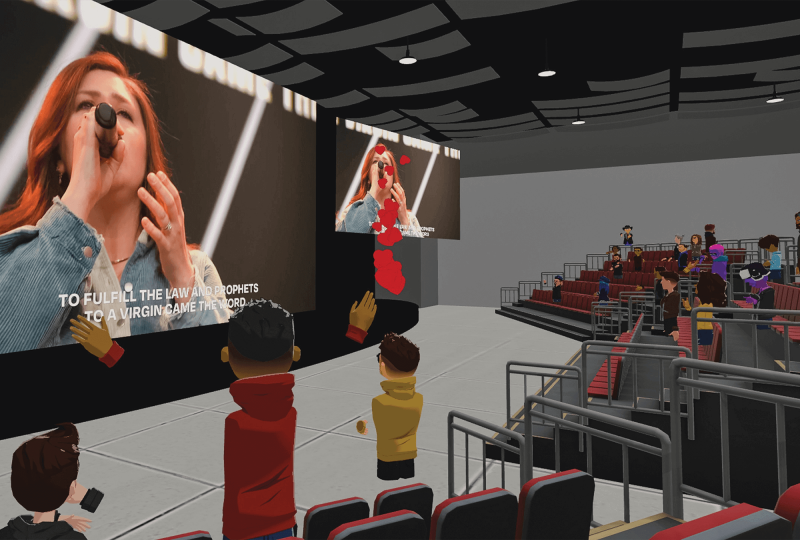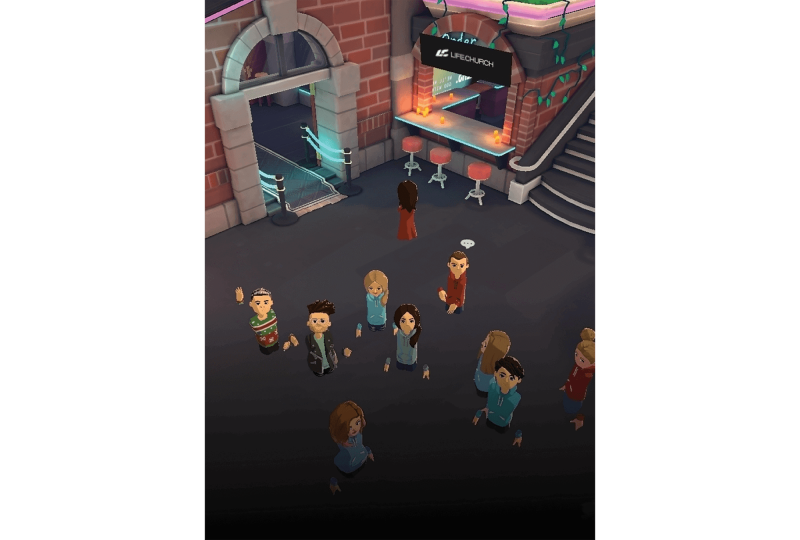IN THE DARKNESS, I heard a voice calling my name: “Hi, Olivia.” I couldn’t control my arms and legs enough to acknowledge the voice. Again: “Hi, Olivia.” At this point I was feeling sheepish. Finally, the voice said to me, “Olivia, I think you’re muted. If you want, you can turn your mic on.”
The voice was that of Steven Roberts, who serves as Life.Church’s online host team pastor. I was attending my first church service in the metaverse.
The darkness faded, and I saw the words “Life.Church” written on the face of a computer-simulated grey, black, and white building. I (or rather my avatar) walked through the building doors into a lobby with welcome signs and informational graphics about the mission and history of Life.Church. There was even a game room with a playable pool table and dartboard. I directed my avatar to the sanctuary.
Life.Church is a multicampus church in the Evangelical Covenant Church denomination. Led by Craig Groeschel and based in Edmond, Okla., it has 44 physical locations in the U.S. and has now ventured into the metaverse.
The metaverse itself is difficult to define. Broadly speaking, it is a shared, immersive, virtual space. Some have referred to it as a 3D version of the internet. For now, the metaverse is plural, meaning multiple platforms have their own “metaverses” disconnected from others. Some have argued that the metaverse itself does not yet exist in its true form, as it will not be fully realized until there is a networked “multiverse” that is not owned solely by a single company.
The metaverse can be used for entertainment, shopping, and gaming. The most optimistic tech enthusiasts see it as a tool for serving others through education, service, and religiosity. Life.Church previously launched a church community in the virtual reality game “Second Life” in 2007, but then paused its efforts. Then came Mark Zuckerberg’s October 2021 rebranding of Facebook as Meta Platforms Inc. Life.Church’s interest in entering the metaverse was reignited as tech companies upped investment in virtual reality and VR headsets became more affordable.
A performance of church
THE LIFE.CHURCH SERVICE began with a video of two stylish young adults (their real selves, not their avatars) welcoming us to Life.Church. They explained that purchasing and wearing their merchandise could change someone’s life forever and talked about tithing to the church as an act of “trust[ing] Jesus with our finances.” We then watched recordings of Life.Church’s worship team performing its original songs. At this point, a message popped up on my screen with an invitation to “unmute and sing out in this place.”
so_lifechurch_3.png

The sermon was a previously recorded video delivered by senior pastor Groeschel. The message itself was refreshing, encouraging Christians to embrace the “both/and”—science and Christianity, faith and doubt. At various points, I turned to look at the 24 “attendees” sitting next to me in the bleachers, feeling a bit embarrassed at my struggles with the controls.
For me, the service didn’t feel like church so much as a performance of church. Despite best efforts to mimic reality, belly laughter and blushing don’t easily reduce to digital code. “Throwing up a heart emoji” in the middle of a sermon doesn’t convey the depth of my relationship with Christ.
Many churches have argued that the metaverse is the next step in reaching some groups, such as people who are avid participants in VR worlds or those who can’t attend worship in person. Zoom church, which grew in popularity due to COVID-19, still feels more rooted to me, with real bodies visible through our screens. The metaverse seems built to circumvent parts of the physical world we want to avoid. In a simulated world, the Christian call to physical works of justice can seem distant.
Another thing I was wary of in that disembodied space: Loss of privacy.
Life.Church provides a disclaimer before entering all their services that the user’s likeness, voice, and username could be licensed and owned by Microsoft Corp. and its metaverse platform, AltspaceVR, for profit and promotion. Life.Church explains that “if you wish to not be recorded, simply leave the event. (But we hope you’ll stay!)”
Both big tech and church communities can reach people and create social connection, which might make them seem like natural partners. But the history of one major player, Meta, isn’t reassuring. Facebook’s record of accelerating the spread of misinformation, careless handling of personal data,and at times intentionally using its algorithm to heighten the insecurities of users is incompatible with the message of the church. As data scientist Frances Haugen testified before a Senate subcommittee in 2021, Facebook prioritizes “astronomical profits” rather than the safety of its users. While the churches that utilize Meta platforms may have good intentions, Meta may not.
so_lifechurch_2.png

On a deeper level, can we find belonging by relying on a platform that promises escape? Jesus warns in the Sermon on the Mount that we must not be like the foolish ones who build their houses on sand. When the winds howl and the floodwater rises, it is not easy to return to our metaverse community, for the code to open the virtual doors only works within the designated service hours. (Although, to be fair, information for calling or emailing a pastor or joining an online or in-person “LifeGroup” was posted in the virtual lobby.)
Outside the metaverse
AT THE END of each Life.Church service, the pastor says, “Whoever finds God,” and the congregation responds, “finds life.” Before the virtual doors dissolved, I listened to conversations among the congregants about the weather and plans to visit flea markets. It sounded like any other post-worship casual conversation. But it left me longing to escape the confines of the metaverse. I wandered out of the digital building, toward fake trees and sky.
Then I closed my laptop and went for a walk.
Later, my mind returned to a moment in the service when one of Life.Church’s leaders walked their avatar toward the altar and invited people to give their lives to Christ. I noticed two people raise their hands. Suddenly, I realized one of the two voices was a child praying, and I couldn’t help but think of my 13-year-old nephew, alone in his bedroom, browsing VR streams between rounds of Roblox and Fortnite, trying to find a community to make him feel connected.
The possibility of people discovering God for the first time through the metaverse is fairly new. Life.Church’s website notes that they will do “anything short of sin to reach people who don’t know Christ.” Including pitching a tent in the metaverse. But I wonder: When the VR headsets are removed, will we recognize God in the physical world?

Got something to say about what you're reading? We value your feedback!







